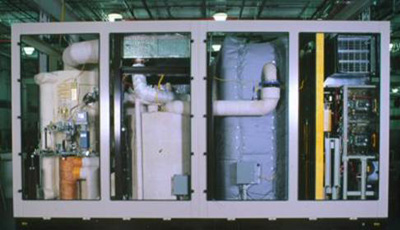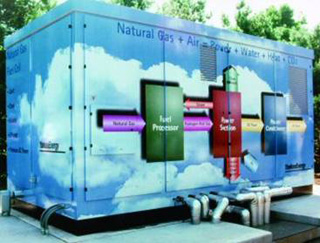PHOSPHORIC ACID FUEL CELL or PAFC

They use concentrated phosphoric acid as an electrolyte, retained in a silicon carbide matrix, with an operating temperature of 150-250 ° C. The electrodes are platinum supported on carbon, with a high sensitivity to CO poisoning. Apart from the alkaline cell, this type of cells are those that have a higher level of technological development, with a wide use in stationary applications in the demonstration phase. This technology has a tolerance to pollutants generated in the process of reforming hydrocarbons far superior to the rest of fuel cells of low temperature, so that its implementation will be easier in the short term.
In 1991 UTC put the first power generation plant based on fuel cell technology on the market. The PureCell� 200 power system (formerly known as PC25) supplies 200KW of electricity and heat (900,000 Btu’s per hour). The accumulated operating time for all the units sold exceeds 6 million hours.


Team that developed a system based on PAFC technology for Allis-Chalmers, 1965.
In the first row and from left to right: Milton Jakola and Merle Engle.
A bit of History
The first single cell of W. Grove in 1939 incorporated sulfuric acid as an electrolyte but the corrosion that it produced limited its development and that is why the possibility of solid electrolytes began to be studied or to use alkaline solutions, less corrosive. In 1961 G.V. Elmore and H.A. Tanner gives the first encouraging results for this technology. During the 60s the United States Navy is very interested in the development of this technology. In this project the cells were built by Allis-Chalmers (who also worked in AFC), Engelhard Industries (was in charge of the reformer) and Varo, Inc. (developed the power inverter). An industrial association known as TARGET or Team to Advance Research for Gas Energy Transformation, Inc., with the sponsorship of Pratt & Whitney (the company from which UTC emerged) and the American Gas Association contributed to its development in an important way. After the energy crisis of the 1970s, many organizations are looking for applications of this technology for the automotive industry.

